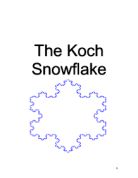as the diagrams are given to us, for the first 4 stages I counted the sides. There is a pattern present, and from that I observed that the number of sides increases by a factor 4 of the previous stage.
From the table above, I can determine the nth term as:
From the graph above, we can observe that the number of sides increases as n increases.
Length of sides
At stage n=0, there is an equilateral triangle which has 3 sides. Those 3 sides each are 1 unit. For the next stage where n=1, each side is divided into 3 parts. Thus the length of the new side is one-third the previous side.
From the table above, I can determine the nth term as:
From the graph above, we can observe that the length of the side decreases gradually as the number of sides increase. They have a limiting value of 0 (tend to 0). X=0 is the asymptote.
Perimeter
The perimeter of the koch’s snowflake can be found by multiplying the length of one side into the total number of sides. The perimeter of n=0 is 3 as 3 sides are multiplied into 1 unit.
The table below has the perimeter of the 1st four stages:
From the above table, the nth term can be determined as
From the graph above we can observe that we can see as the number of sides increase (n), the perimeter also increases.
Area
The area of the 1st stage at n=0 is , as the shape changes in the 2nd stage, the area increases to the area of the first triangle+ area of new triangles
-
A1 = A0 + area of new triangles
There is an area scale factor present, which is .
-
A1 = A0 + new triangles × × A0
A1 = A0 (1 + new triangles × )
At the 2nd stage the area scale factor becomes
= (×).
The table below has the areas of the 1st four stages:
A0: × 12 =
: A0 (1 + new triangles × )
: (1 + 3 × )
A1: (1 +)
Stage 2 has 12 new triangles and also the scale factor becomes square of the previous scale factor. So it is
A2: A1+ new area
: A1 + (12 ×× )
: (1 + ) + 12 × ×
A2: (1 + + )
The formula can be generalized here:
An: (1 + ( +++… …+ )
Area Graph
The area graph above highlights that as the n increases the area also increases. It is directly proportional.
Generalizations and predictions
As we know the nth term for Nn, Ln, Pn and An we can now predict the results for terms till n=6.
A4:
:
: 0.68268303
: 0.68268000 (5s.f.)
The table above has values of n from 0-20.
From the table we can observe that from the 17th term, the area of An+1 equals An to 6 decimal places.
Also from the table, we can see that at n=15, the area is 0.69281897 and as you go ahead, the consecutive terms start to have very minute changes and the difference isn’t a lot.
The 17th term: 0.69282006
18th term:0. 69282020
The difference between the two only is 0.00000014, which is very minute. This shows that as the n increases and goes up to infinity the area increases very minutely (tends to 0).
Limits and Scope
The calculator and the ms excel provided acute values along with sufficient amount of significant figures.
The limitations could be that there is no possibility of finding the value for n= ∞
Bibliography
- intro
- picture of snowflake
- the four stages
- curves







